Tacx Flow Smart Trainer review - yes, it has its flaws, but it’s incredible what you do get for the price
An excellent introduction into the world of smart trainers
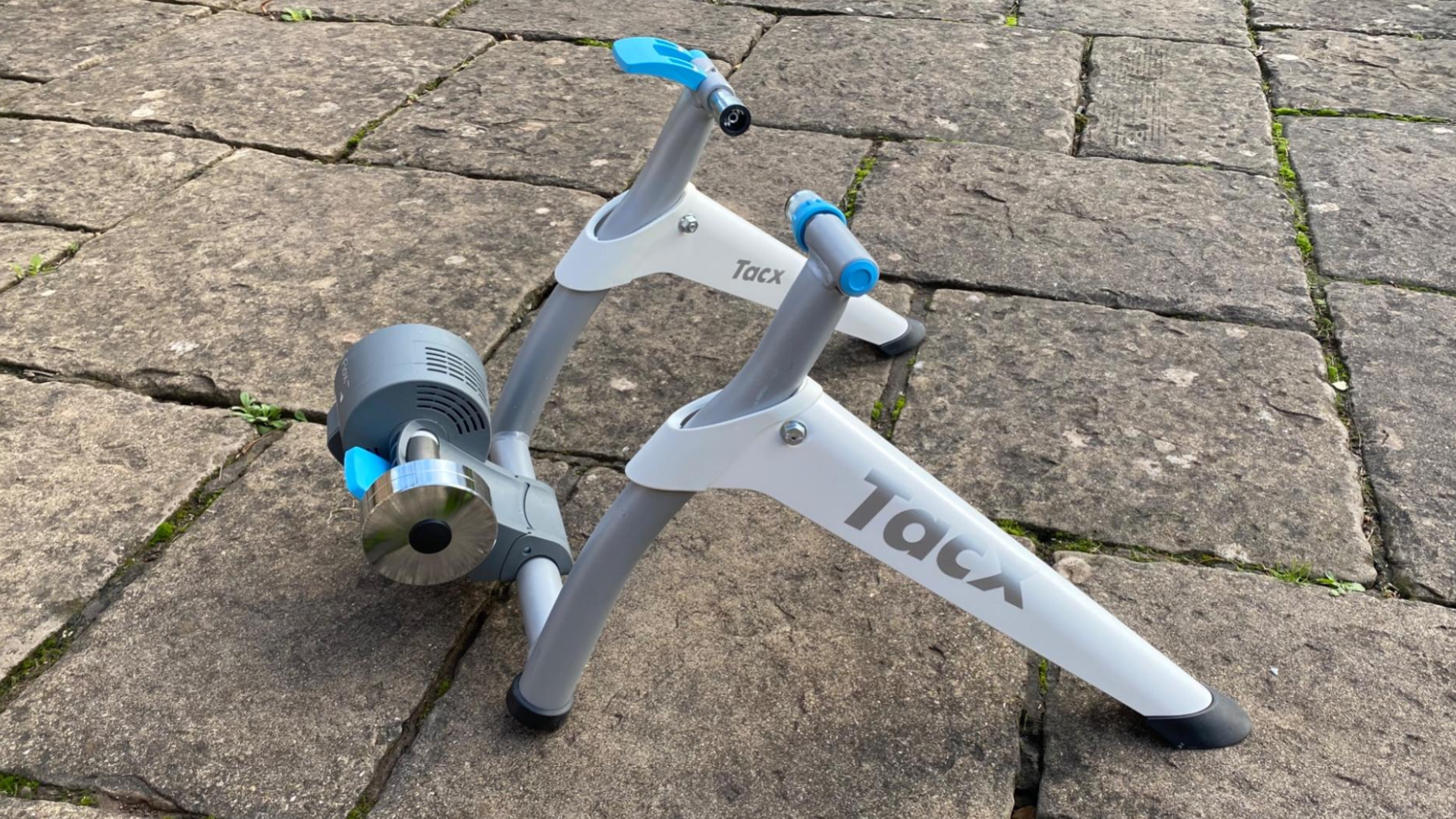
An effective wheel-on trainer with solid power reading capabilities. It’s lightweight, quiet in use, and superb value. The only downfall of this trainer is that the power readings are lower than, say, a pedal power reading, plus the ERG mode and resistance changes are sluggish. However, this trainer is a superb introduction to using a smart trainer for an incredibly low price.
-
+
Great value price
-
+
Easy setup
-
+
Power data consistent with top-end power meters
-
-
No thru axle adaptors included as standard
-
-
Calibration can be a faff
-
-
Not as accurate as direct drive competitors
-
-
ERG mode and resistance changes are sluggish
You can trust Cycling Weekly.

The Tacx Flow is certainly a very accessible means of getting connected up to the best indoor cycling training apps. The wheel-on design keeps the price low, yet you’ll be able to ride with power and ‘feel’ gradients up to six per cent on the virtual roads. It performs well, is lightweight and fairly silent to use and, in all, represents very good value, making it one of the best cheap smart turbo trainers.
Tacx Flow: construction
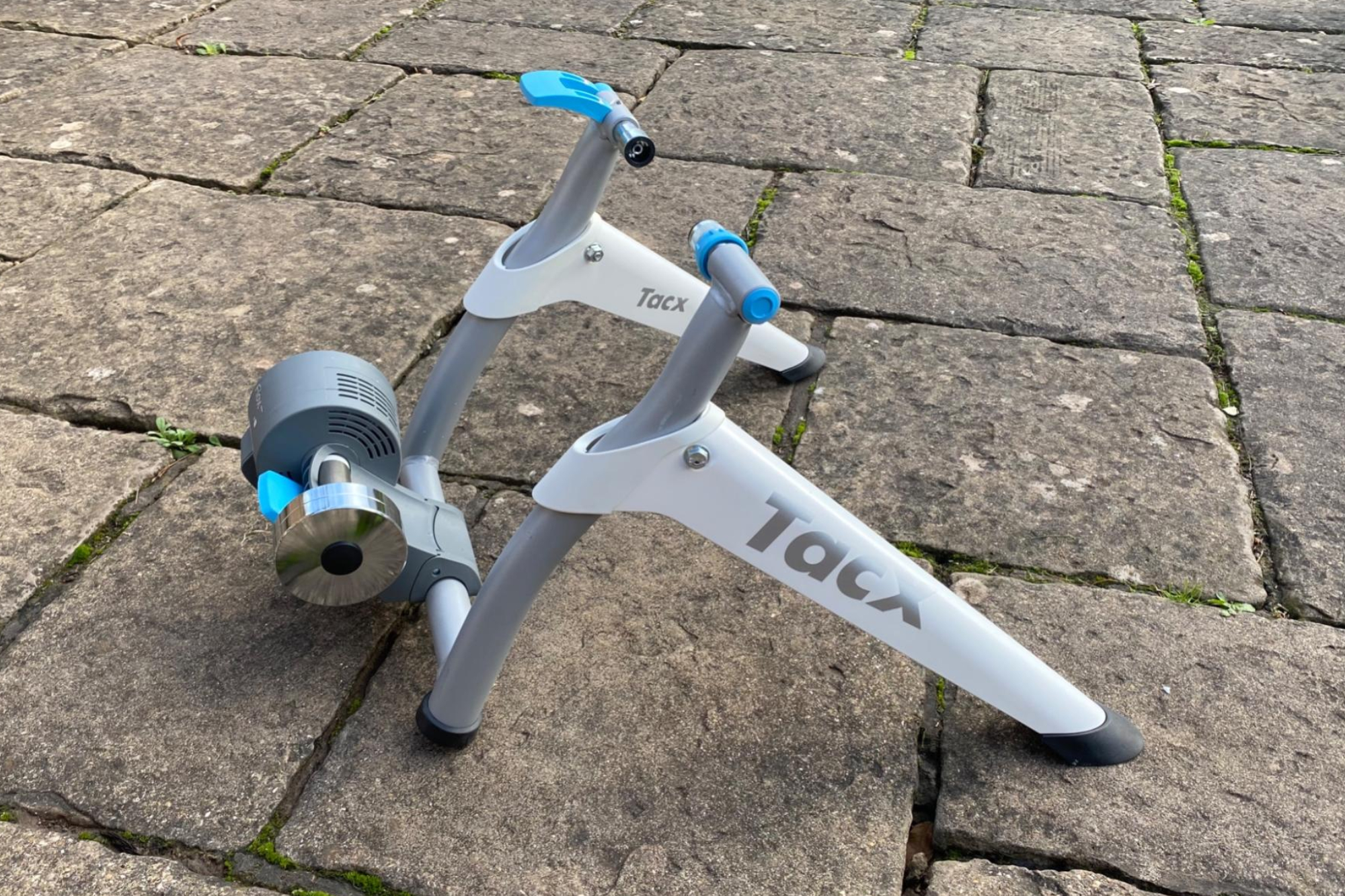
Straight out the box, the Flow is very easy to set up. It’s a simple case of folding the legs out, and then attaching the resistance unit on either the position 1, for 700c wheels, or position 2, for 650b wheels. Then you fit the special QR skewer to your rear wheels and fix the bike securely. All that’s left after that is getting the resistance roller set up the right distance apart. All in all, the initial setup took less than 10 minutes.
The Tacx Flow is also very light at under 10kg, making it an ideal trainer to bring to events for warm ups, as it can be used without being connected to a power source. However, using it without a power source will mean that you don’t get the power reading functionality.
The wheel-on setup is a tried and tested design and, thanks to the use of noise silencing plastics to dampen vibrations, this is one of the quietest wheel-on trainers I’ve used. In the largest gear going full gas, the noise does build – but that’s unavoidable when the wheel is turning at 45mph.
Speed, power and RPM are all measured and data is communicated via BLE and ANT+, so it will work with most bike computers and laptops, tablets and Apple TV. The 1.6kg flywheel allows gradient simulation of up to 6%, while maximum resistance power is 800 watts. Accuracy is claimed at 5%, which is a good level for a wheel-on trainer.
Tacx Flow: the ride
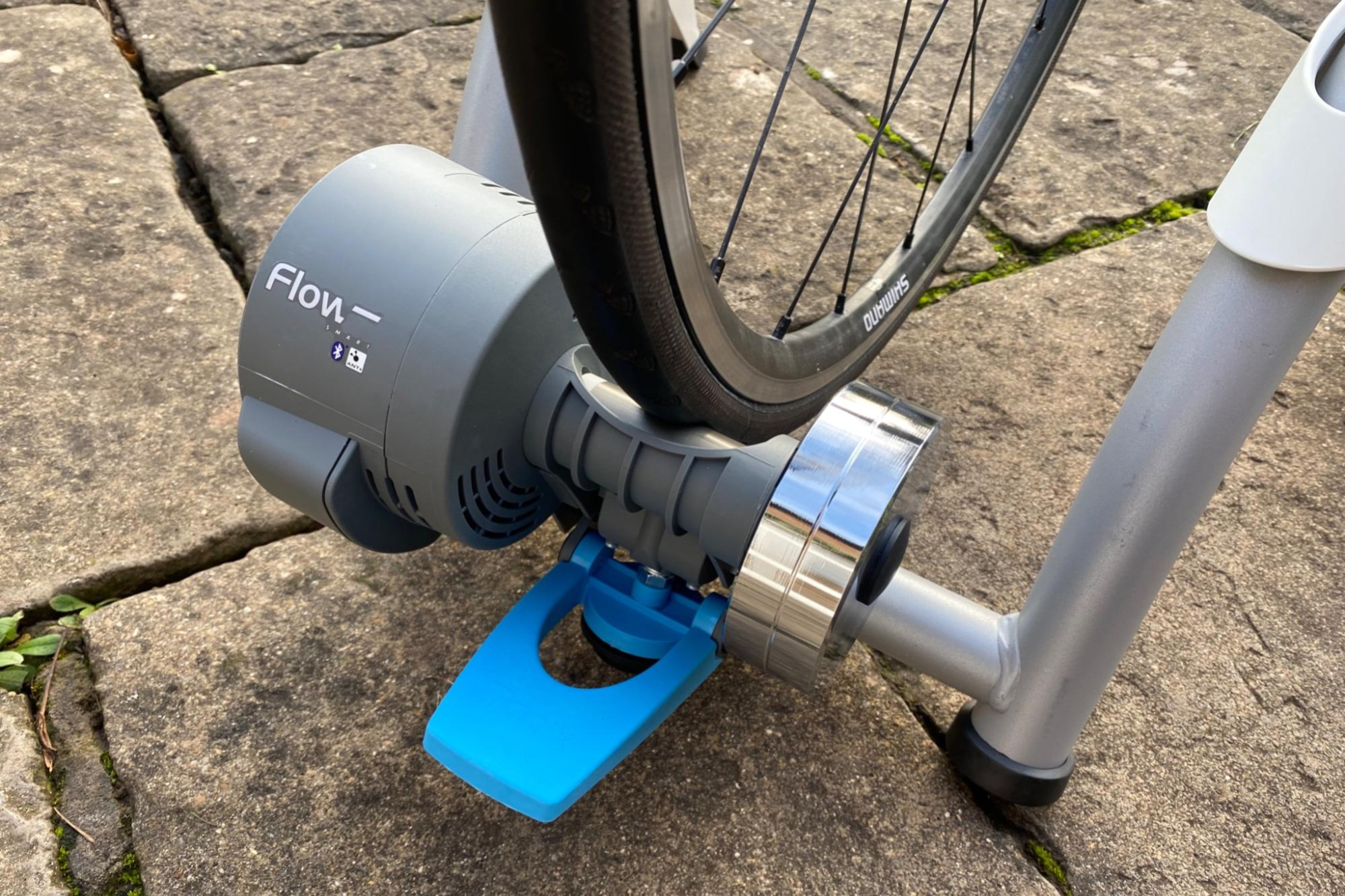
The first ride I did on the Tacx was a free ride with a Pace Partner on Zwift just to get things running. I warmed up for 10 minutes first so as to be able to do a proper calibration. The comparison device I used was the Wahoo Powrlink dual sided pedals which we’ve previously reviewed and found to be very accurate. I’ve also found the pedals track well with my Wahoo Kickr V5.
There is a significant difference in power readings between the Tacx Flow and the Wahoo Powrlink dual, so – as you’d expect – the accuracy of the Tacx doesn’t appear to be on the same level as higher end power meters.
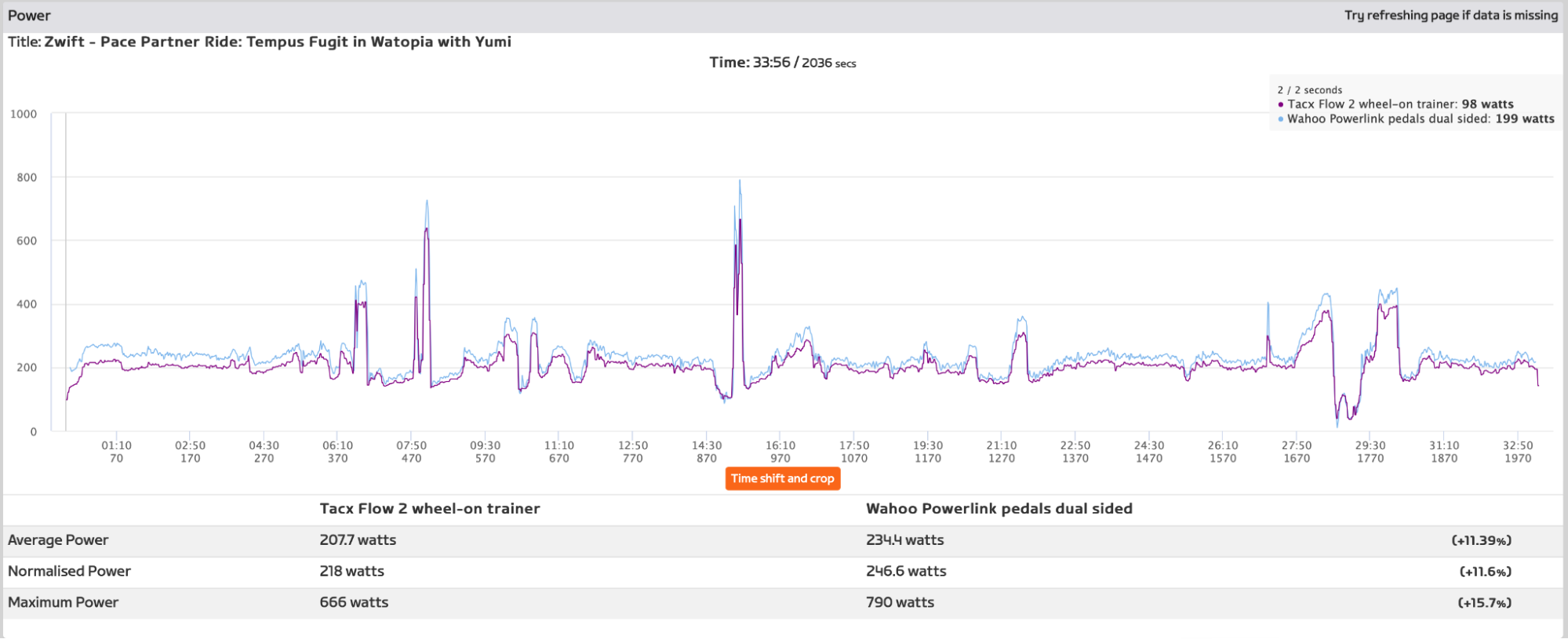
However, some of that difference can be explained by where the power is being read from. For the pedals, the reading is very close to the source of the power (the leg) so fewer watts are being wasted on chainrings, chain, cassette and wheel. By the time the power is read at the wheel, several watts are lost to the drivetrain – so you would expect the trainer to read lower.
Most relevantly, the difference in power reading between the Tacx Flow and the Wahoo Powrlink Dual is fairly consistent across the power curve – and it’s this consistency that is key. Even though the power readings are a bit lower, you can adjust the power targets of your training sessions downwards and still be working in the correct cycling training zones, which is all that’s needed for improving your fitness.
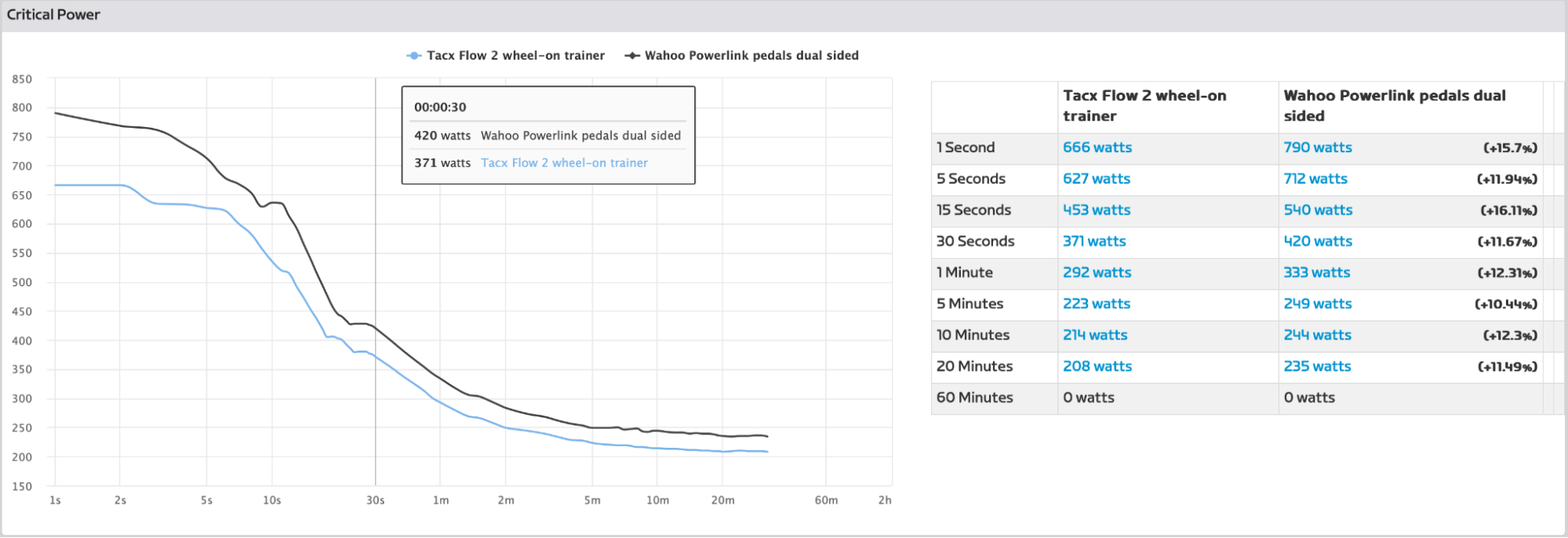
One issue I did have with the Tacx was accelerating on Zwift. Often, I would start a sprint with very little resistance, only for it to ramp up significantly after a second or two – spinning too easily to start only for the resistance to come crushing after the delay. Equally, I found that the Tacx Flow would also give some very big resistance increases when the gradient increased by only 1 or 2 percent, so I had to set the trainer realism to zero.
Using ERG mode does control the resistance well, but it can take a little while for the resistance to kick in. For longer intervals or steady state rides this works perfectly well. For micro intervals or shorter efforts where there are on/off style repeated efforts, the delay in ERG pickup is noticeable and it would be better to complete those without ERG and using gearing to get the right resistance.
The trainer itself feels well planted and there were no stability issues when doing sprint or out of the saddle efforts. The wheel riser block really helps with this feeling of stability.
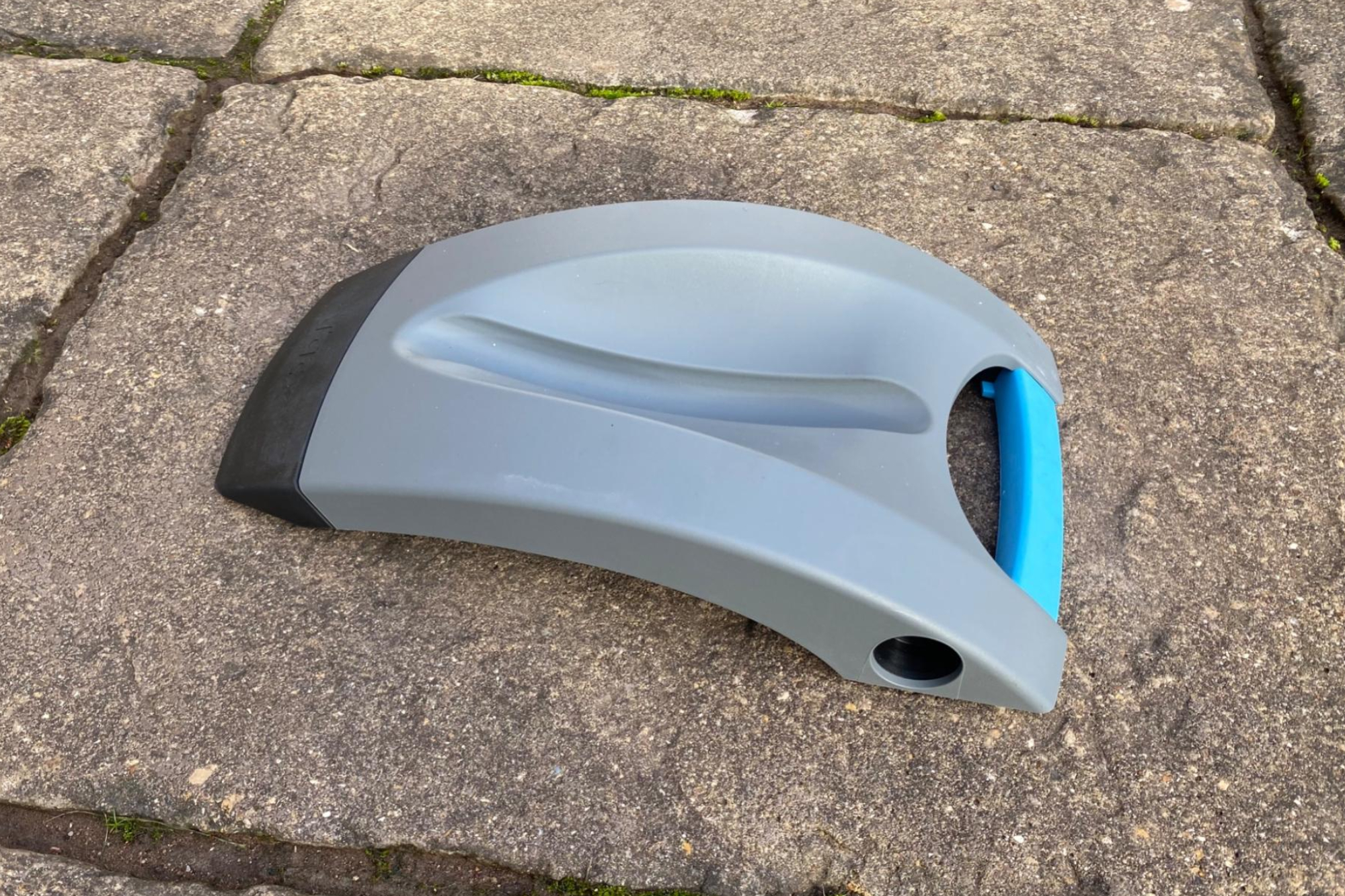
It was also very easy to set up and get the resistance block at the right distance to the wheels to optimise the resistance on the tyre. Sound wise the trainer is not too loud unless you end up in the highest gear doing bigger efforts with the wheel going at 50+mph! I found when not using an app to control resistance, then the highest sustainable power I could maintain at 110RPM in the 53/11 was 400ish watts. Fine for most riders, but larger and more powerful riders likely won’t find this enough.
Calibrating the trainer was hit and miss. Initially it was easy after 10 min of spinning and getting everything up to temperature. First time everything was good, but after seeing the difference between the Flow and the pedals, I recalibrated. Initially it said that I needed to tighten the resistance unit to get an accurate reading. I did this by a quarter turn, same message. Did it again, calibration error. It did sort itself out in the end, but I would be worried about the problem recurring.
Tacx Flow: value and conclusion
Value-wise, this trainer really does come into its strong point. Similar products are the Wahoo Kickr Snap ($399.99 / £429.99), the Elite Tuo ($579.99 / £445), and the Saris Fluid 2 ($329.99 / £299.99). At $369.99 / £299.99 (and readily available for less than that online) it undercuts most of the competition for smart wheel-on trainers.
I can’t comment on the Saris Fluid 2, but in terms of functionality the Wahoo and Elite are functionally better trainers, however they both cost significantly more. In terms of practicality, the Tacx is a little better thanks to being lighter and a bit more stable. This lower weight also doesn’t affect stability.
All these trainers are available online for good discounts at the moment, but the Tacx comes in at the lowest price, and given the comparative functionality and practicality, it does come in at very good value for an intro into smart trainer use and also as a highly portable warm up device for races.
Wheel-on trainers are often a great option for a trainer that has power reading capabilities while also being more portable and not requiring a power source to still be useful for pre-race warm ups. The Tacx Flow is a very capable wheel-on trainer, especially for such a low price compared to the competition. The power reading appears to be consistent for a wheel-on trainer, and consistent across the power curve so good for gauging power levels and improvements. ERG mode and resistance changes can be a little sluggish, but overall the trainer works very well for most people’s training requirements. Those wanting top level accuracy and realistic ride feel should go for a direct drive trainer. But for those wanting a solid trainer at superb value that offers power measurement, this trainer is nearly as good as the best wheel-on trainers but for more than $100 / £100 cheaper!

Thank you for reading 20 articles this month* Join now for unlimited access
Enjoy your first month for just £1 / $1 / €1
*Read 5 free articles per month without a subscription

Join now for unlimited access
Try first month for just £1 / $1 / €1
Get The Leadout Newsletter
The latest race content, interviews, features, reviews and expert buying guides, direct to your inbox!
Andy is a Sport & Exercise Scientist, fully qualified and experienced Cycling Coach, Sports Director, Freelance Writer, and Performance Consultant. He spent 3 years riding for a UCI cycling team and 7 years as a BC Elite rider, competing in prestigious events such as the Tour of Britain and the Volta a Portugal.
Graduating with a first-class honours degree in Sport & Exercise Sciences, he continues to pursue his interest in research in the field of Sport Science alongside managing his coaching business, ATP Performance. He also works as a Wind Tunnel operator and Performance Consultant at the Silverstone Sports Engineering Hub, working with individuals, teams, and businesses to optimise performance and develop products.
-
 Broken hips, hands, and collarbones: Paris-Roubaix's lengthy injury list lays bare brutality of race
Broken hips, hands, and collarbones: Paris-Roubaix's lengthy injury list lays bare brutality of race"It probably wasn't the best idea to continue," says one of weekend's many wounded riders
By Tom Davidson Published
-
 Remco Evenepoel hails end of 'dark period' and announces racing return
Remco Evenepoel hails end of 'dark period' and announces racing returnOlympic champion says comeback from training crash has been 'the hardest battle of my life so far'
By Tom Thewlis Published
-
 A bike rack with an app? Wahoo’s latest, and a hub silencer – Sea Otter Classic tech highlights, Part 2
A bike rack with an app? Wahoo’s latest, and a hub silencer – Sea Otter Classic tech highlights, Part 2A few standout pieces of gear from North America's biggest bike gathering
By Anne-Marije Rook Published